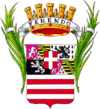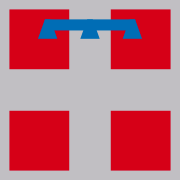Cuneo
| Cuneo | ||
|---|---|---|
| Comune | ||
| Città di Cuneo | ||
|
Church of St. Francis. | ||
| ||
 Cuneo Location of Cuneo in Italy | ||
| Coordinates: 44°23′22″N 7°32′52″E / 44.38944°N 7.54778°ECoordinates: 44°23′22″N 7°32′52″E / 44.38944°N 7.54778°E | ||
| Country | Italy | |
| Region | Piedmont | |
| Province | Cuneo (CN) | |
| Frazioni | Bombonina, Borgo San Giuseppe, Cerialdo, Confreria, Madonna delle Grazie, Madonna dell'Olmo, Passatore, Roata Canale, Roata Rossi, Ronchi, San Benigno, San Pietro del Gallo, San Rocco Castagnaretta, Spinetta, Tetti Pesio | |
| Government | ||
| • Mayor | Federico Borgna | |
| Area | ||
| • Total | 119.67 km2 (46.20 sq mi) | |
| Elevation | 534 m (1,752 ft) | |
| Highest elevation | 615 m (2,018 ft) | |
| Lowest elevation | 431 m (1,414 ft) | |
| Population (31 December 2017) | ||
| • Total | 56,281 | |
| • Density | 470/km2 (1,200/sq mi) | |
| Demonym(s) | Cuneesi | |
| Time zone | UTC+1 (CET) | |
| • Summer (DST) | UTC+2 (CEST) | |
| Postal code | 12100 | |
| Dialing code | 0171 | |
| Patron saint | Saint Michael | |
| Saint day | September 29 | |
| Website | Official website | |
Cuneo (Italian: [ˈkuːneo] ![]()
It is located at 550 metres (1,804 ft) in the south-west of Piedmont, at the confluence of the rivers Stura and Gesso.
Cuneo is bounded by the municipalities of Beinette, Borgo San Dalmazzo, Boves, Busca, Caraglio, Castelletto Stura, Centallo, Cervasca, Morozzo, Peveragno, Tarantasca and Vignolo.[1]
It is located near six mountain passes:
- Colle della Maddalena at 1,996 metres (6,549 ft)
- Colle di Tenda at 1,871 metres (6,138 ft) - Tunnel of Tenda at 1,300 metres (4,300 ft), 3 kilometres (1.9 mi) long
- Colle del Melogno at 1,027 metres (3,369 ft)
- Colle San Bernardo at 957 metres (3,140 ft)
- Colle di Nava at 934 metres (3,064 ft)
- Colle di Cadibona at 459 metres (1,506 ft).
History
Cuneo was founded in 1198 by the local population, who declared it an independent commune, freeing themselves from the authority of the bishops of Asti and the marquisses of Montferrat and Saluzzo. In 1210 the latter occupied it, and in 1231 the Cuneesi rebelled. In 1238 they were recognized as free commune by Emperor Frederick II.
In 1259 the independence of Cuneo ceased forever, as it gave itself, also to take protection against its more powerful neighbours, to Charles I of Anjou, who was then King of Naples and Count of Provence. Together with Alba, it was the main Angevine possession in Northern Italy; their rule (in fact interrupted by periods under Saluzzo, Savoy, the Visconti of Milan) ended in 1382 when Cuneo was acquired by the Duchy of Savoy.
Cuneo became an important stronghold of the expanding Savoy state, and was thus besieged by France several times: first in 1515 by Swiss troops of Francis I of France, then again in 1542, 1557, 1639, 1641, 1691 and, during the War of Austrian Succession, in 1741. In all the sieges Cuneo resisted successfully. Cuneo was conquered by France only during the Napoleonic Wars, when it was made the capital of the Stura department. After the restoration of the Kingdom of Sardinia, and the unification of Italy, Cuneo became the capital of its namesake province in 1859.
During World War II, from 1943 to 1945, it was one of the main centres of partisan resistance against the German occupation of Italy.
Main sights
- Villa Oldofredi Tadini, built in the 14th and 15th centuries as a watchtower. It is now a museum housing collections of the owners, the Mocchia and Oldofredi Tadini families.
- Villa Tornaforte, surrounded by an English-style park.
- Civic Museum
- Railway Museum
- Churches of Santa Croce, San Giovanni Decollato and Santissima Annunziata, housing paintings by Giovan Francesco Gaggini.
- Panoramic funicolar that connects plateau to Gesso river.[2]
- Monument of Stura and Gesso in Torino Square
- The median way of the plateau (Rome Avenue, Galimberti Square and Nice Avenue): the commercial heart of Cuneo.[3]
- New Bridge (Ponte Nuovo) between the center of the city and Madonna dell' Olmo
- Monument at Peano's curve
- Palazzo Uffici Finanziari (PUF), highest edifice in the city at about 50 metres (160 ft)[4]
Subdivisions
Most important and populated: Centro storico, Cuneo centro, Cuneo nuova, San Paolo, Donatello, Gramsci, San Rocco, Cerialdo, Confreria and Borgo San Giuseppe.[5]
Climate
Cuneo has a temperate sub-continental climate, with cold winters and hot, dry summers. However, it is situated more than 500 metres (1,640 feet) above sea level, which helps to make summers more bearable: the hottest month, July, has an average temperature of 21.6 °C (70.9 °F). The coldest, January, averages 1.7 °C (35.1 °F). Annual precipitation is about 962 mm (37.9 in), distributed over 81 days. The rainfall pattern is similar to that of Turin, with two maxima—one primary and one secondary (spring and autumn) and two minima (summer and winter). The driest month is July, 44 millimetres (1.7 in). Snowfalls are frequent owing to high elevation and wind patterns.
| Climate data for Cuneo | |||||||||||||
|---|---|---|---|---|---|---|---|---|---|---|---|---|---|
| Month | Jan | Feb | Mar | Apr | May | Jun | Jul | Aug | Sep | Oct | Nov | Dec | Year |
| Average high °C (°F) | 5.3 (41.5) |
7.0 (44.6) |
10.9 (51.6) |
14.7 (58.5) |
19.1 (66.4) |
23.6 (74.5) |
26.6 (79.9) |
25.4 (77.7) |
21.5 (70.7) |
15.4 (59.7) |
9.6 (49.3) |
6.3 (43.3) |
15.5 (59.8) |
| Daily mean °C (°F) | 1.7 (35.1) |
3.1 (37.6) |
6.7 (44.1) |
10.4 (50.7) |
14.5 (58.1) |
18.7 (65.7) |
21.6 (70.9) |
20.7 (69.3) |
17.2 (63) |
11.6 (52.9) |
6.2 (43.2) |
2.9 (37.2) |
11.3 (52.3) |
| Average low °C (°F) | −1.8 (28.8) |
−0.7 (30.7) |
2.6 (36.7) |
6.1 (43) |
9.9 (49.8) |
13.9 (57) |
16.6 (61.9) |
16.1 (61) |
13.0 (55.4) |
7.8 (46) |
2.9 (37.2) |
−0.4 (31.3) |
7.2 (44.9) |
| Average precipitation mm (inches) | 52 (2.05) |
51 (2.01) |
88 (3.46) |
116 (4.57) |
126 (4.96) |
88 (3.46) |
44 (1.73) |
53 (2.09) |
77 (3.03) |
109 (4.29) |
94 (3.7) |
64 (2.52) |
962 (37.87) |
| Average rainy days | 5 | 5 | 8 | 9 | 10 | 8 | 5 | 5 | 6 | 8 | 7 | 5 | 81 |
Cuisine and food
Cuneo's specialty is Cuneesi al rhum, small meringues with dark chocolate coating and a rum-based chocolate filling. They are a creation of Andrea Arione (1923), who also registered the name, and sold them in the bar still located in the central square, Piazza Galimberti; another claim makes them a creation of pastry chef Pietro Galletti from Dronero. Another specialty is "raviolini al plin", a small ravioli pasta made with meat and vegetables. The most famous brand there is Pastificio Boetti, also located close to the central square.
Sport
Volleyball
There is an important volleyball club, Piemonte Volley who won 1 Italian Volleyball League, 3 CEV Cup, 2 CEV SuperCup, 4 Italian Volleyball Cup and 3 Italian Volleyball SuperCup.
Football
Associazione Calcio Cuneo 1905 (A.C. Cuneo 1905) who plays in the 3rd level of Italian football.
Cycling
Many times stage of Giro d'Italia. In 2016, for the first time in the Giro history, the race arrived in Sant'Anna di Vinadio sanctuary, the highest sanctuary in Europe, 2035 m, and the day after, on May 29, the race started from Cuneo. Since 1987 Cuneo has been the start and arrival point of the amateur international race "La Fausto Coppi".
See also
Notable people
- Annibale Santorre di Rossi de Pomarolo, Count of Santarosa (1783–1825), early Risorgimento leader.
- Franco Andrea Bonelli (1784–1830), ornithologist, entomologist and collector.
- Giuseppe Peano (1858–1932), mathematician.
- Giovanni Battista Ceirano 1860 - automobile pioneer, joint founder of Ceirano, Well-Eyes bicycles, Well-Eyes cars - the first F.I.A.T., SCAT (Società Ceirano Automobili Torino)
- Matteo Ceirano 1870 - automobile pioneer, joint founder of Itala Fabrica Automobile and S.P.A. (Società Piemontese Automobili)
- Ernesto Ceirano 1875 - Winner of 1911 and 1914 Targa Florio in SCAT automobiles.
- Giorgio Federico Ghedini (1892–1965), composer.
- Tancredi "Duccio" Galimberti (in Italian) (1906–1944), a lawyer, against fascists, Italian National Hero.
- Nuto Revelli (1919–2004), partisan and writer.[6]
- Alviero Martini (born c.1940), fashion designer.
- Cesare Damiano (born 1948), politician.
- Carlo Petrini (born 22 June 1949), born in the province of Cuneo in the commune of Bra in Italy, is the founder of the International Slow Food Movement. In 2004, he founded the University of Gastronomic Sciences, a school intended to bridge the gap between agriculture and gastronomy.
- Piergiorgio Odifreddi (born 1950), mathematician, logician and aficionado of the history of science.
- Livia Turco (born 1955), politician.
- Michele Ferrero (1925–2015) patriarch of Italian chocolate dynasty Ferrero Group. He inherited the company from his father Pietro in the 1950s and turned it into one of the world's largest confectionery makers, whose brands include Ferrero Rocher hazelnut chocolates, Nutella and Tic Tac.
Twinnings



Cuneo is also twinned with the contrada della Selva of Siena, Italy.
References
- ↑ "inhabitants Cuneo and bordering municipalities". Comuniverso.it. Retrieved 2013-06-24.
- ↑ Comune di Cuneo - Portale Istituzionale - Ascensore panoramico verso Piscina Comunale
- ↑ Comune di Cuneo - Portale Istituzionale - Foto Gallery
- ↑ La Stampa.it Panorama Cuneo
- ↑ "Quartieri di Cuneo" (in Italian). Comune di Cuneo. Retrieved 2013-06-24.
- ↑ Nutorevelli.org
- ↑ "Villes jumelées avec la Ville de Nice" (in French). Ville de Nice. Archived from the original on 2012-10-29. Retrieved 2013-06-24.
External links
| Wikimedia Commons has media related to Cuneo. |
- Cuneo homepage, comune.cuneo.it (in Italian)
- Giornale di informazione della Provincia di Cuneo, grandain.com (in Italian)
- Parco Fluviale Gesso e Stura, www.parcofluvialegessostura.it (in Italian)

